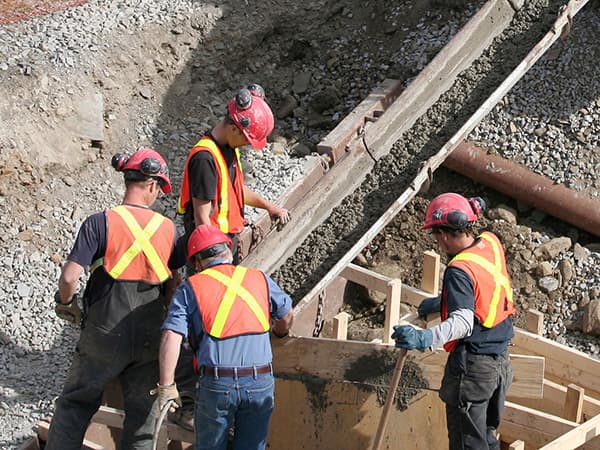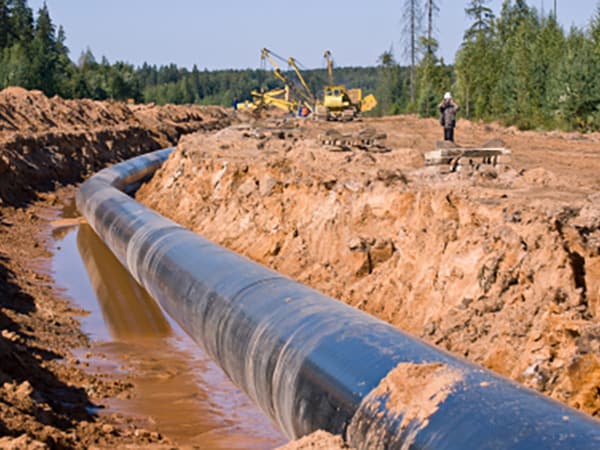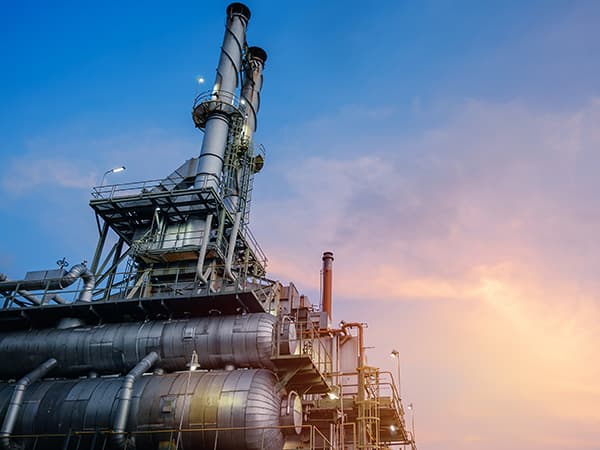Introduction
If you’ve ever set foot on a construction site or an industrial warehouse, you might know that hazardous substances will likely be on the premises.
With climate change and energy conservation being at the forefront of most conversations surrounding the environment today, we must look at something else that helps us maintain clean environments both on the work site and surrounding areas.
That ‘something’ is ‘secondary containment.’ This article aims to run down the idea and principles of secondary containment and the types of equipment used to store and contain hazardous materials to keep the jobsite and surrounding environment clean.
** This article is provided for informational purposes only.
What’s Secondary Containment?
The straightforward definition of secondary containment (sometimes described as secondary spill containment) is the containment of hazardous liquids to prevent the pollution or contamination of soil and water.
Modern construction and industrial sites usually use spill berms to contain oil-filled equipment, fuel tanks, truck decks, or any other equipment that may leak hazardous liquids. Portable containment berms are basins or reservoirs that can catch many dangerous fluids and chemicals.
These berms help contain mobile equipment as well, such as oil drums, trucks, tankers, and trailers. For instance, if you parked a diesel-fuelled, hydraulic forklift inside a containment berm, if any fuel, oil, or hydraulic fluid were to leak out, the berm wall would catch it and prevent it from seeping into the soil.
What Are Spill Berms Usually Made Of?
Typically, portable spill containment berms are made from materials called geomembranes. These are synthetic fabrics designed with a low permeability membrane, which controls fluid migration in a structure or system.
These geomembranes, like the fabric Hyprene™, are derived from raw polymer resins and additives like antioxidants, plasticizers, fillers, carbon, and lubricants, which create the properties that give secondary spill berms their thickness, density, and other mechanical properties like tear resistance.
Essentially, you need a material that’s harsh enough to stand up to hazardous liquids, which makes secondary containment necessary. Other cheaper geotextile spill containment can lead to the solidification of oils, while geomembrane berms do not.
Is There a Difference Between ‘Spill Containment’ and ‘Secondary Containment’?
There is a slight difference between these two terms. However, both spill containment and secondary containment look to achieve the same goal: preventing hazardous liquids from spreading to the surrounding environment.
You’re right to think we’re splitting hairs here, but both objectives are needed to maintain safety and regulation compliance in a work environment where you store hazardous materials.
What’s the Difference?
Alright, here's what it comes down to. It's beneficial to think of spill containment as the primary form of containment. It's the first line of defense against spills. Examples of primary containment would be drums, cans, bottles, or carboy bottles that store the hazardous material. For example, a drum full of crude oil or a fuel tank full of diesel is the primary spill containment or the primary containment.
Therefore, you should view secondary containment as the 'backup plan' should the spill containment fail. Call it a necessary plan B, if you will. Should the primary spill containment fail, whether it's a punctured drum, or a leaking tank, the secondary containment is there to mitigate the damage by collecting or controlling the container's contents. Secondary containment comes in many forms, including the mentioned spill berms, pallets, absorbing pads, and much more.
Is Secondary Containment Regulated Anywhere?
As we’ve discussed, secondary containment is vital to protecting both workers and the surrounding environment. For this reason, the Occupational Safety and Health Administration (OSHA) has regulations regarding secondary containment requirements.
These requirements can vary depending on which country, province or state the work is performed. It’s, therefore, imperative to know the regulations applicable to where you are for secondary containment.
For example, Environment Canada lists that your secondary containment system must, “...be able to hold a volume greater than or equal to 110% of the largest tank or storage container and cover at least the entire surface under each machine, tank, or container.”
Let’s give a quick example:
If we have a drum with a volume of 42 L that needs a containment berm we can calculate that 110% of that is 46.2 L. Therefore, we would need a secondary containment berm that meets that volume to meet the Environment Canada recommendation to store the drum.
Depending on where the work is being done, different regulations and standards will be applicable.
The Environmental Protection Agency (EPA) offers regulations regarding secondary containment in addition to any mandates by organizations like OSHA. The reason is that different entities need to be examined in case a spill occurs. For example, the EPA primarily focuses on the environmental implications of a spill, whereas OSHA deals more with the workers involved.
What about multiple drums in one containment area?
Let's look back at the EPA code 40 CFR 264.175. It states: "The containment system must have sufficient capacity to contain ten percent of the volume of containers or the volume of the largest container, whichever is greater."
Let’s give another example with this code…
If we have two 210 L drums (55 US gallons) that need secondary containment, we have a total volume of 420 L. Using 10% of that colume (420L) is 42 L. Based on the EPA code, the volume of the largest container (210 L) is greater than 10% of both containers (42 L). Therefore, a secondary containment solution capable of holding 210 L is required to be compliant.
However, if we're dealing with 20 drums that need containment that have a volume of 210 L each, those drums have a total of 4,200 L. 10% of that total volume for all those containers is 420 L, which is greater than the volume of the largest container (210 L).
Therefore, you would need a containment berm that can hold 420 L of material for the twenty drums being contained to be compliant.
Discussing Passive and Active Secondary Containment
You can divide secondary containment into two different classes: passive and active. No, one type of secondary containment doesn’t jog regularly, while the other doesn’t. These definitions center on the preparedness or pre-existence of the containment.
Essentially, active containment refers to when a form of secondary containment needs to be deployed at the time of a spill rather than already being in place. In contrast, passive containment means that the secondary containment solution is already in place before a spill occurs.
Active containment, meanwhile, requires the means of containment to be deployed by the workers as quickly as possible (and as safely as possible) to curb the effects of a spill.
Some prefer passive secondary containment as it requires no human intervention to be effective, which reduces the risk of exposure to workers.
At the same time, an active form needs to be implemented and requires workers to be near the spill and likely wearing proper Personal Protective Equipment (PPE).
Passive Secondary Containment and Examples
As discussed, passive containment means that the means of containment is pre-installed. Passive methods require no installation action on behalf of your team if a spill occurs. The containment system is already present and capable of containing the spilled substance and preventing contamination of the surrounding area.
Passive secondary containment can come in different forms, including spill containment berms, which we have already discussed. Spill containment pallets and pre-installed dyke systems are also good examples.
Many methods of passive containment, like spill berms, can be very cost-effective and give peace of mind to workers in case a spill occurs and the berms are already installed.
It’s important to note that for passive containment utilized outdoors, employers must also account for the potential for precipitation to build up within the secondary containment system. While it is acceptable for precipitation to build up within your secondary containment, the potential for precipitation accumulation must be accounted for when determining the volume requirements for your secondary containment solution.
Active Secondary Containment and Examples
Active secondary containment requires workers to implement the methods of containment when a spill occurs.
Implementing active methods can be done in many different ways, with products such as absorbent pads, manually-engaged berms, socks, diverters, drip pads, or even oil-solidifying polymers to absorb or redirect any spill flow to keep it away from contaminating the surrounding environment.
Depending on the strength of the chemicals on site and the work site's surrounding landscape, active secondary containment methods could be more suitable.
What is soil contamination?
Soil contamination occurs when the concentration of pollutants in the soil is higher than usual. Soil contamination occurs mainly due to the impact of past activities that took place on the site that impacted the ground.
Causes of soil contamination
Various impacts can lead to soil contamination. Looking at an industry like mining, for instance, can release sulfuric acid, arsenic and mercury into the soil.
Hydrocarbons can also be released during fuel storage and lead can be released in steel working. Demolition work can also lead to things like asbestos being released into the environment. Human, agricultural and industrial wastes can also contaminate soil when things like leaks, spills or pipeline ruptures occur.
But soil contamination isn’t confined just to work sites and industry. Metal, coal slags or contaminated dredge spill have been previously as a general backfill in low lying urban areas, which can lead to soil contamination when modern construction projects break ground and the excavation process releases contaminants into the surrounding environment.
Impact on construction projects and secondary containment
This is where secondary containment can come in to prevent these issues from occurring down the road and keep the area clean.
Simply being next to contaminated soil causes unexpected issues for project managers and engineers. Flooding or groundwater flow can transfer contaminants to the untouched soil. This is where objects like berms, dividers or diverters can come in to act as a boundary wall and prevent contaminant migration.

If these factors can’t be managed, contaminated soil can harm the environment or anybody who comes into contact with it. Nobody would feel very comfortable taking possession of their new home, only to find out that the builder spread contaminants all over the soil by their new home.
Legally, the responsibility rests on the property owners or any nominated developers to manage contaminated soils that arise from construction projects depending on local regulations and best practice guidelines. Secondary containment can be invaluable in preserving soil quality. Not only can it lead to unsafe conditions, but it delays progress and profitability.
If all that doesn’t give you a headache, it’s already compounded by the fact that most regions mandate the contaminated soil must first be classified and then removed off-site by a contractor. Doing this degree of site maintenance means dollar signs for the hired contractor but an expensive setback for the operators of the work site.
Let’s Discuss Water Contamination
I defy you to name a more important element to life than water. Granted, that was a loaded challenge, but dealing with water near a job site to prevent contamination can be demanding.
Significant water pollution incidents can arise too quickly on job sites without careful planning and cause budget-busting delays—issues with water contamination compound with wet weather and other precipitation that can exacerbate the contamination effects.

Simply stripping a layer of topsoil may create pollution when it rains—construction involving chemicals such as paint, solvents, fuel, and concrete also presents risks.
Potential pollutants from storage tanks, contaminated ground and groundwater can all come into play.
We’ve already driven home that secondary containment holds potentially harmful chemicals and hydrocarbons, so spills, leeching and leaks don’t shut down your job site. But let’s look at some of the leading causes of water contamination, as decried by the EPA.
Suspended Solids (Silty Water)
This is the most common source of pollution on construction sites. Suspended solids occur when a construction site strips the topsoil, removing the most robust defense against erosion and vegetation. The remaining surface doesn't have a shield or 'binding' to protect it from rainfall and runoff. When you remove the plant matter and compact the surface with machinery, this increases the runoff rate.

As machinery churns the ground, it releases soil particles that sit in the surface water and get added to the runoff. Even though soil is a natural part of the environment, when it accumulates in runoff, it can get into nearby drains and watercourses, where it can become an issue.
There are some industrial fabric solutions, like berms, dividers, dyke systems, and drain/utility hole covers, that help the soil contaminants from entering the sewer. Constructing settlement ponds nearby will also help manage suspended solids, but these can take up a lot of space[SM3] . Industrial clarifiers can also be used to mitigate soil contamination.
Hydrocarbons (Oil)

You'll likely find substances like gasoline, diesel, kerosene and other oils on most job sites. Contaminants from hydrocarbons can occur primarily in spills that get absorbed into the land or pipe breakages from refueling and busted hoses.
There are some active and passive secondary containment measures to minimize these types of contaminating events. Oil spill kits and dividers come to mind, as well as using large containment berms for refueling vehicles or tankers to park in that provide adequate volume coverage for containment in case a spill occurs.
Conclusion
Dealing with contamination is an inherent risk in construction or industrial work. Secondary containment is a potent preventative measure in the arsenal of modern-day workers to contain hazardous substances and not inflict heavy damage to the surrounding area and environment.
Through passive and active measures, secondary containment is invaluable in meeting the demands and regulations required to keep work safe and environmentally friendly. Equipment like berms, dividers and dyke systems have proven to be robust safeguards against hazards that can lead to soil and water contamination.
Coupled with regulatory standards from groups like OH&S, OSHA and the EPA, businesses can take solace in their containment systems to avoid costly removal procedures, curb environmental and climate damage, and ensure the safety of their employees and work site operation.
By doing so, we actively prevent contamination and pave the way for a cleaner, safer and more environmentally conscious future for all.
